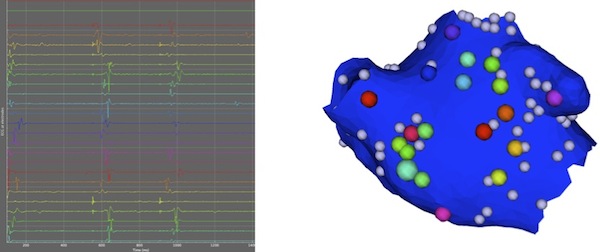Analyzing the intracardiac measurements for understanding of cardiac arrhythmia based on pacing sequences
- Ansprechperson:
- Projektgruppe:
Medizinische Messtechnik, Digitale Signalverarbeitung
Atrial arrhythmia is a change in the normal heart rate and rhythm due to physiological or pathological reasons. Atrial fibrillation is the most common cardiac arrhythmia. Around 0.5 percent of the world population is suffering from this condition. This condition increases with age and could lead to stroke, hospitalization, as well as lost productivity. Catheter ablation is the commonly used technique to cure atrial arrhythmia. In this procedure lines of non-conducting tissue are created with RF currents in the atria, in order to limit the patterns of electrical excitation to organized activity. However the success rate of the treatment is still moderate. With the perfect positioning of the scar, the false electric phenomena can be stopped.
In order to mark the region creating abnormal activity, the concept of triggering and pacing sequences has emerged. The pacing triggers are given to the patient from the coronary sinus and the
wave front due to these pacing’s are analyzed in a three dimensional map. The tissue behavior is analyzed. Tissue having scar or damaged tissue will have no or comparatively slow conduction and therefore these areas can be marked, observing the depolarization waves. It was further shown that since the atrial tissue is heterogeneous in nature therefore instead of one global conduction velocity we always have regions with slow and fast conduction.

In collaboration with Klinikum Karlsruhe, a stimulus-based study is done for better understanding of the depolarization wavefront generated from the sinus node and coronary sinus. Therefore, the proposed study can lead to a better understanding of the atrial arrhythmia mechanisms on the 3 dimensional map and also can help in better treatment planning.

